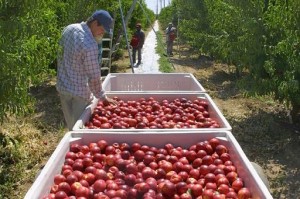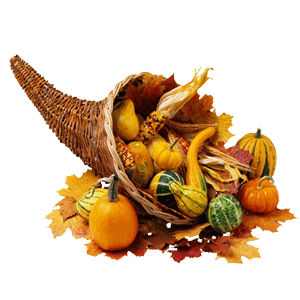By Diana Marcum,
Los Angeles Times
Reporting from Fresno—
As Californians savor their Thanksgiving feasts, the states’ farmers are especially thankful.
California’s agriculture sector is on track for a record year, a rare bright spot in the state’s economy.
Prices for cotton, grapes and other crops are near all-time highs. Foreign buyers are gobbling California almonds, grapes, citrus and dairy products. Agricultural exports through September are up 16% over the same period last year. Net farm income is projected to post strong gains in 2011 after nearly doubling over the previous decade.
At a time when other Golden State industries are struggling, times are good down on the farm. Just ask Steve Moore. The Fresno County pistachio farmer recently completed the harvest on his 480-acre spread near Huron, part of what’s estimated to be California’s second-largest pistachio crop ever. Prices are
strong, at around $2.10 a pound, driven by growing demand in places including
China and Israel. Moore started with 160 acres in 1982, planting trees that take seven years to produce. “Looking at those bare sticks in the ground, I thought I must be nuts,” he said. But the crop is so lucrative he’s looking to expand again.
Indeed, prices for all manner of farm products are so high that Vernon Crowder, an agricultural economist with Rabobank, a major agricultural lender, has been seeing some
unfamiliar faces at industry events.
“When you go to ag conferences you now have venture capitalists hanging around,” he said. “But they find it very difficult to beat out another farmer for land, and that shows you how strong the
market is. There’s been a fundamental shift as the global market demands more food and more expensive food.”
That’s good news for California, the nation’s leading agricultural state and the fifth-largest producer worldwide. In contrast with the grain-and-livestock focused Midwest, California farmers cultivate more than 400 commodities, including more than half of the nation’s fruits and vegetables.
Looking for artichokes? Dates? Kiwi? Pomegranates? California accounts for more than 99% of the U.S. production of each of those crops, according to the California Food and Agriculture Department.
“You ask the average person what California does better than any other place in the world, where we have the most innovation and natural advantage and they’ll probably say Hollywood or high-tech. But, it’s farming,” said Stuart Woolf, president of Woolf Farming & Processing, with cotton and tomato fields near Huron.
“Bakersfield to Sacramento is like a giant greenhouse with really good soil,” he said. “The big picture is that we are going to be perpetually stretching our resources as California feeds more people around the
globe.”
The world’s population just hit 7 billion, and emerging middle classes in countries such as India and China are putting more on their plates. California farmers, always looking for new markets, are finely attuned to shifting economies and tastes worldwide. Pistachios are a perfect example of such entrepreneurial farming.
California is now the world’s top producer, knocking off longtime leader
Iran three years ago. This year the state’s crop is expected to be more than 460 million pounds, but 30 years ago the crop barely existed here. Then came the 1979 Iranian hostage crisis, which led to a ban on imports from Iran, a major supplier to the U.S. market. Some Central Valley farmers saw an opportunity. They gambled on planting pistachio trees. Innovation followed.
Iranian pistachios traditionally are dyed a distinctive red to cover blemishes left by bits of the
hull sticking to the outer shell. California researchers found a way to remove the outer hulls, leaving the tan shells smooth and flawless. Soon California pistachios were favored by consumers worldwide. The 2010 crop — a record 522 million pounds — was worth $1.16 billion. In the Central Valley, which grows about 95% of the nation’s pistachios, the crop is expected to nearly double by 2017 as more trees mature.
“That’s a huge increase. But we think we’ll be able to create demand ahead of production,” said Richard
Matoian, executive director of American Pistachio Growers in Fresno.
Moore, the pistachio farmer, is willing to roll the dice. He’s looking to add more trees. “It’s a moon shot – a trajectory of seven years. You water, you fertilize, you keep the critters away, and you hope and you pray the demand grows as your trees grow,” he said.
The country’s largest pistachio farm, Paramount Farms, is capitalizing on Hollywood glitz to build a
bigger domestic market. Located in Kern County, Paramount is owned by Stewart and Lynda Resnick, who created the national pomegranate juice craze in part by putting their POM Wonderful brand juice bottles in gift bags at entertainment awards shows. Paramount is now pushing pistachios with “Get
Crackin” TV spots featuring personalities such as Cameron and Tyler Winklevoss, who had accused
Facebook Inc.’s
Mark Zuckerberg of stealing their idea for the social network, promoting “the
lowest calorie nut.”
“California farmers have guts,” Matoian said. “They take risks on new crops.”
Sometimes they return to old ones.
California was once a major cotton grower, transplanting the “white gold” empires of the South to the American West. But cotton slowly disappeared as drought and water wars drove farmers to abandon it for other crops.
Then prices spiked in 2010, largely because of poor harvests in China and
Pakistan, which are major
cotton growers. Some Golden State farmers rushed to plant cotton anew. Now, the Texas drought is expected to push high-end pima cotton prices to the $3-a-pound mark again. California farmers are harvesting 454,500 acres of cotton, almost 50% more than last year.
“Anything, anywhere in the world, affects us,” said Ryan Jacobsen, a raisin grower and executive director of the Fresno County Farm Bureau.
So far the concurrence of events has California agriculture prospering and poised for long-term growth. China is still a surging market, and the U.S. recently signed a trade deal with Korea that is expected to boost exports of wine, beef, dairy products and tree nuts.
But Jacobsen said it would be hard to find a big-spending California farmer who would freely admit to
being flush. “You know how you make a small fortune in farming? Start with a large fortune,” he said.
The most splurging that raisin grower Steve Spate will do is an occasional dinner out with his wife, even though raisin prices are at an all-time high of $1,700 a ton, more than double what they were in 2002.
Fall rainstorms almost ruined this year’s crop. And immigration crackdowns and ongoing violence on the U.S.-Mexico border have left him struggling to attract enough farmhands.
Spate plans to invest this year’s profits to strengthen trellises to prepare for the switch to mechanical
harvesters. “In farming what you buy is the ability to keep farming,” he said.





